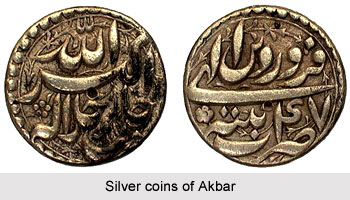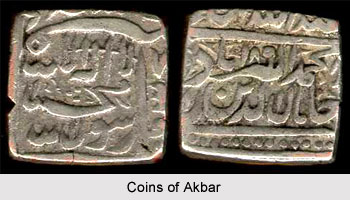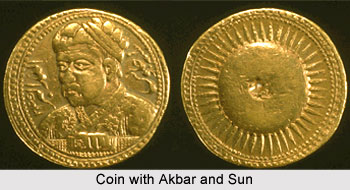 During the reigning period of Akbar, the Mughal Empire reached to the peak of success. The Mughal emperor helped to elevate the empire by accelerating the cultural, social and the economic affairs of the era.
During the reigning period of Akbar, the Mughal Empire reached to the peak of success. The Mughal emperor helped to elevate the empire by accelerating the cultural, social and the economic affairs of the era.
Coins of Akbar include the gold, silver and copper coins. The Mughal emperor used to create the coins that followed the patterns of Suri coinage and gradually the weight and fabric of the coinage were also adopted. The gold coins that were created during the time of Akbar are now known as `muhar`. According to Abul Fazl, Akbar had issued gold coins of several values. During this period, the heavy weight coins were common but with the progression of time, the light weight coins became common and the heavy weight coins became rare. Before 988 A.H (Islamic calendar) no fractional coins in any metal came into existence. Later some fractional coins were used in all metals though they were rare. Besides, these coins meant for the entire empire, some coins were also issued on the local pattern in gold and silver. Gold coins were similar to those issued in the time of Humayun and silver coins were issued from Gujarat, Malwa and Kashmir. These coins followed the patterns that were popular then in the respective territories.
The shape of the coins of Akbar was round and later was changed to square for gold and silver coins. The round and square coins were issued simultaneously during 993 A.H. to 998 A.H. Later the square shaped coins were abandoned and almost all the coins of the later period were issued in round shape. Akbar had also issued some commemorative gold coins in Mihrabi shape i.e. hexagonal with oblong upper and lower sides and left and right sides of the shapes of domes. The coins of Akbar were distinguished for the styles he incorporated along with the shape and weight of the coins. The coins gained the distinct characteristics due to the content of their inscriptions. Till 1585 A.D. the gold and silver coins were issued in the `Kalima` type. They followed the earlier `Shahrukhi` coins of the early Mughal emperors like Babur and Humayun. The coins were issued with the `Kalima` on the obverse with the names of the four Khalifas. On the reverse side of the coin was the emperor with or without the titles, the pious wish, the name of the mint with or without an epithet and the date in the Hijri era. The dates in the Hijri era were inscribed in a regular manner till 98 A.H. then the word `Alif` was put on them to represent 1000.
 The coins of Akbar also reflect the change in the religious thinking of the emperor. During this period the `Kalima` was removed from the coins and its place was given to the Ilahi creed Allah Akbar Jalla jalalah. Including these, the name and titles of the emperor were also withdrawn. The Ilahi coins issued after 1585 A.D. may be distinguished into four types. The earliest coins bear the Ilahi creed exclusively. The coins bore the inscription of Allah Akbar on one side and Jalla jalalah on the flip side of the coin. These coins were issued in the thirteenth year of the reign of Akbar. The second type has a similarity with the first type but had the year with the word Ilahi on the Jalla jalalah side. Later the third type was introduced and the full Ilahi creed was placed on one side of the coin and the dates in two lines were engraved on the other side of the coin. In these coins, Akbar introduced an innovative way which is remarkable in the Indian numismatic history. From this time onwards, the coins issued bore the names of the month of issue. Though the suspension of the mint name continued, with the issue of the third type, the mint name was reintroduced.
The coins of Akbar also reflect the change in the religious thinking of the emperor. During this period the `Kalima` was removed from the coins and its place was given to the Ilahi creed Allah Akbar Jalla jalalah. Including these, the name and titles of the emperor were also withdrawn. The Ilahi coins issued after 1585 A.D. may be distinguished into four types. The earliest coins bear the Ilahi creed exclusively. The coins bore the inscription of Allah Akbar on one side and Jalla jalalah on the flip side of the coin. These coins were issued in the thirteenth year of the reign of Akbar. The second type has a similarity with the first type but had the year with the word Ilahi on the Jalla jalalah side. Later the third type was introduced and the full Ilahi creed was placed on one side of the coin and the dates in two lines were engraved on the other side of the coin. In these coins, Akbar introduced an innovative way which is remarkable in the Indian numismatic history. From this time onwards, the coins issued bore the names of the month of issue. Though the suspension of the mint name continued, with the issue of the third type, the mint name was reintroduced.
Akbar introduced the use of metrical legends on some of his gold and silver coins and after Akbar this was practised by most of his successors as well. The earliest coins with a couplet were issued but were suspended shortly after. They were reissued and were continued till the end of his reign. Another metrical legend on gold was used on the coins of Agra mint and the metrical legend is observed on silver coins on the Allahabad issues. Silver coins with the metrical legend were issued on the conquest of Bandhogarh. Akbar also reintroduced the pictorial motifs on some of his coins. The gold coins that were issued to commemorate the conquest of the fortress of Asirgarh, the stronghold of Khandesh, bear a hawk on one side and the mint name and the date on the other side of the coin. Some silver coins of another type manifesting Akbar riding a horse with a hawk were perhaps issued on this occasion. In later years, the mint less gold and silver coins were issued. The effigy of Ram and Sita with the words `Rama Siya` in Nagari was observed on the top of one side of the coin. Another pictorial coin was also issued in the same year, which bore the picture of duck on the coin.
 The copper coins which were also known as `dam`, was the fortieth part of a silver rupee. The fractional coins of it were `nisfi` or `adhelah` (half), `paula` or `rabi` or `damra` (quarter) and `damri` (one eighth). Akbar issued this type of coins till the forty fourth year of his reign. After these coins a new coin termed as `tankah` was introduced and it was just twice the weight of the `dam` (664 grains). The `dam` was given a fractional status with the introduction of these new denominations and it was termed as `nim tankha` (half tankah). After a short span of time, another series of copper coins were issued from Ahmedabad, Agra, Delhi and from some places outside India and they came to be known as `tanki`. With some exceptions, the copper coins of Akbar followed the copper coinage of Babur and Humayun in respect of the legends. They only had the name of the mint with the words `fulus` or `Sikka fulus` on the obverse and the date in Persian words on the reverse. Later with the introduction of Ilahi era, the Ilahi month and year were placed on this side. When the `tankah` and `tanki` coins were introduced, the obverse had the value suffixed with the word `Akbar Shahi`. The mint name was now placed on the reverse along with the date. In time of Akbar, the mint names got importance and since then they became an integral part of the Mughal coins. The steady territorial expansion of Akbar`s empire was accompanied by the expansion of the mints. Over twenty names are seen on the gold coins and about forty five on the silver coins. In the beginning, regular mints for gold were situated at the provincial capitals and afterwards Delhi was added to the list. But the mint at Delhi was soon closed and Ahmedabad took the position when Gujarat was conquered. Similarly, coins were issued from Patna after Bihar was attached to the empire. These mints, which struck gold coins, also issued silver and copper coins. In addition to that, there were three or four mints which issued only silver and copper coins. Apart from that, copper coins were issued from many other places.
The copper coins which were also known as `dam`, was the fortieth part of a silver rupee. The fractional coins of it were `nisfi` or `adhelah` (half), `paula` or `rabi` or `damra` (quarter) and `damri` (one eighth). Akbar issued this type of coins till the forty fourth year of his reign. After these coins a new coin termed as `tankah` was introduced and it was just twice the weight of the `dam` (664 grains). The `dam` was given a fractional status with the introduction of these new denominations and it was termed as `nim tankha` (half tankah). After a short span of time, another series of copper coins were issued from Ahmedabad, Agra, Delhi and from some places outside India and they came to be known as `tanki`. With some exceptions, the copper coins of Akbar followed the copper coinage of Babur and Humayun in respect of the legends. They only had the name of the mint with the words `fulus` or `Sikka fulus` on the obverse and the date in Persian words on the reverse. Later with the introduction of Ilahi era, the Ilahi month and year were placed on this side. When the `tankah` and `tanki` coins were introduced, the obverse had the value suffixed with the word `Akbar Shahi`. The mint name was now placed on the reverse along with the date. In time of Akbar, the mint names got importance and since then they became an integral part of the Mughal coins. The steady territorial expansion of Akbar`s empire was accompanied by the expansion of the mints. Over twenty names are seen on the gold coins and about forty five on the silver coins. In the beginning, regular mints for gold were situated at the provincial capitals and afterwards Delhi was added to the list. But the mint at Delhi was soon closed and Ahmedabad took the position when Gujarat was conquered. Similarly, coins were issued from Patna after Bihar was attached to the empire. These mints, which struck gold coins, also issued silver and copper coins. In addition to that, there were three or four mints which issued only silver and copper coins. Apart from that, copper coins were issued from many other places.
The time of Akbar was remarkable as the designs of the coins during the time of Akbar had got the originality with technical designs and minting process. Mughal coinage during Akbar truly reflects originality and innovative technique. Innovations like ornamentation of the background of the coin with floral scrollwork were introduced during this time.



















